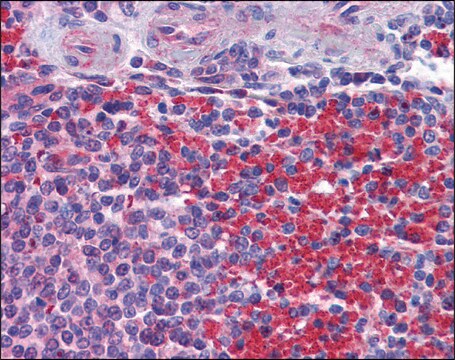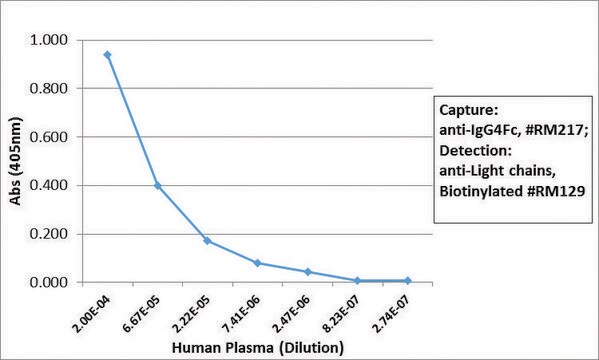추천 제품
생물학적 소스
mouse
결합
unconjugated
항체 형태
purified immunoglobulin
항체 생산 유형
primary antibodies
클론
7-1H, monoclonal
양식
buffered aqueous solution
분자량
antigen ~130 kDa
종 반응성
mouse, human
농도
~2 mg/mL
기술
immunocytochemistry: suitable
western blot: 2-4 μg/mL using total cell extract of Raji cells
동형
IgG1
UniProt 수납 번호
배송 상태
dry ice
저장 온도
−20°C
타겟 번역 후 변형
unmodified
유전자 정보
human ... CIITA(4261)
mouse ... Ciita(12265)
일반 설명
Class II transactivator protein (CIITA) protein contains an acidic region in its N-terminal with transactivation activity, that binds to proteins in the basal transcription machinery and to cAMP response element-binding protein (CREB)-binding protein (CBP). The protein contains motifs for nuclear translocation, GTP binding motif and C-terminal leucine-rich repeats. CIITA is expressed constitutively in B lymphocytes and in immature dendritic cells, while in other cells its expression is induced by IFN-γ .
Monoclonal Anti-CIITA (mouse IgG1 isotype) is derived from the hybridoma 7-1H produced by the fusion of mouse myeloma cells (Sp20 cells) and splenocytes from BALB/c mice immunized with purified N-terminal recombinant CIITA, amino acids 1-350. CIITA is expressed constitutively in B lymphocytes and in immature dendritic cells, while in other cells its expression is induced by IFN-γ.
Monoclonal Anti-CIITA recognizes human1 and mouse † CIITA.
Monoclonal Anti-CIITA recognizes human1 and mouse † CIITA.
애플리케이션
The antibody may be used in immunoblotting (∼130 kDa) and immunocytochemistry.
생화학적/생리학적 작용
Class II transactivator protein (CIITA) interacts with specific transcription factors and creates the appropriate transcriptional scaffold required for HLA-D gene expression.
물리적 형태
Solution in 0.01 M phosphate buffered saline, pH 7.4, containing 15 mM sodium azide.
면책조항
Unless otherwise stated in our catalog or other company documentation accompanying the product(s), our products are intended for research use only and are not to be used for any other purpose, which includes but is not limited to, unauthorized commercial uses, in vitro diagnostic uses, ex vivo or in vivo therapeutic uses or any type of consumption or application to humans or animals.
적합한 제품을 찾을 수 없으신가요?
당사의 제품 선택기 도구.을(를) 시도해 보세요.
Storage Class Code
10 - Combustible liquids
WGK
WGK 3
Flash Point (°F)
Not applicable
Flash Point (°C)
Not applicable
개인 보호 장비
Eyeshields, Gloves, multi-purpose combination respirator cartridge (US)
가장 최신 버전 중 하나를 선택하세요:
Giovanna Barbieri et al.
International immunology, 14(8), 839-848 (2002-07-31)
The class II transactivator (CIITA) controls both the constitutive and IFN-gamma inducible expression of HLA-D genes. In addition, through the squelching of another transactivator CREB-binding protein, CIITA was more recently shown to have a wider cellular function, including cell cycle
H Zhou et al.
Journal of immunology (Baltimore, Md. : 1950), 158(10), 4741-4749 (1997-05-15)
The MHC class II transactivator gene (CIITA) coordinately controls the expression of the three major human class II genes, HLA-DR, HLA-DQ, and HLA-DP. Indeed, patients with one form of MHC class II immunodeficiency disease, due to defective CIITA genes, lack
Isoforms of the class II transactivator protein
Barbieri G, et al.
International Immunology, 14(8), 839-848 (2002)
W Wiszniewski et al.
Journal of immunology (Baltimore, Md. : 1950), 167(3), 1787-1794 (2001-07-24)
The expression of MHC class II molecules is essential for all Ag-dependent immune functions and is regulated at the transcriptional level. Four trans-acting proteins control the coordinate expression of MHC class II molecules: class II trans-activator (CIITA), regulatory factor binding
Rodrigo Naves et al.
International immunology, 14(5), 481-491 (2002-04-30)
MHC class II expression defects have been evidenced in several human tumor cell lines originating from lung cancers or retinoblastoma. Accordingly, the mouse adenocarcinoma and fibrosarcoma cell lines, RAG and L(tk-), do not express I-A and I-E molecules even when
자사의 과학자팀은 생명 과학, 재료 과학, 화학 합성, 크로마토그래피, 분석 및 기타 많은 영역을 포함한 모든 과학 분야에 경험이 있습니다..
고객지원팀으로 연락바랍니다.








